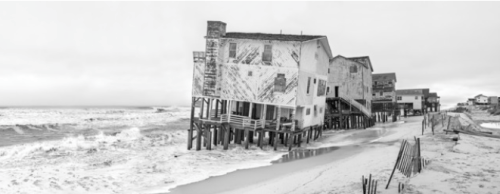
A photography exhibit about a politically contentious topic can easily turn into agitprop. But thanks to careful curation and wise use of the medium, Carroll Square Gallery’s exhibit about climate change serves as an understated and eloquent meditation on its subject.
The three photographers whose works comprise “Shoreline” document a relatively modest area of the eastern seaboard—Maryland’s Eastern Shore (photographed by Greg Kahn), the Hampton Roads area of Virginia (Glen McClure), and the Outer Banks of North Carolina (Miller Taylor). But that’s more than enough to generate pathos about the future.
McClure makes large, black-and-white portraits of people in Norfolk, Va., whose jobs are shaped by the tides, from shipbuilding riggers to underwater divers. The August Sander-esque images are quietly authoritative, both from their visuals and from a series of brief but compelling captions.
Diver and ex-Marine Don Forrest Brown is seen in a protective suit splattered by mud and water, while pioneering female shipfitter Sharon Harris, a 42-year-veteran of the shipyards, looks like she takes no guff, even as the caption adds that she enjoys making tiny dollhouses and raising parakeets.
Taylor’s images are composed with equal care, but instead of portraits they are distinctly horizontal landscapes, limned in subtle, washed-out shades of black and white. One documents a vital bridge in a rigorously geometrical fashion; another shows a branch of driftwood resting on sand under a fair-weather sky. The third of Taylor’s three images is the most notable; it shows a house teetering on the water’s edge, still standing but damaged by a storm beyond all repair.
Kahn’s collection of images, meanwhile, melds the best of his colleagues’ portraiture and landscape work.
One hazy, delicate photograph by Kahn features an isolated, dead tree partially inundated by salt water—an expressive image that documents the slow, steady invasion of a force that’s deadly to the tree’s continued survival. Another image shows a two-lane road that’s in the midst of being washed out, while a third is an aerial image of shorelines depicted in tones of amber and blue in what appears to be the late afternoon sun.
But Kahn’s portraits pack even more of a wallop—one of a mud-splattered oyster shucker who can split up to 5,000 a day, and the other of a crab picker, partly hidden behind a pile of crustaceans, wiping her brow. Her gesture surely stems from exhaustion, but it could also serve as a symbol of the forces that are slowly and inexorably shaping life in this uneasy corner of America.